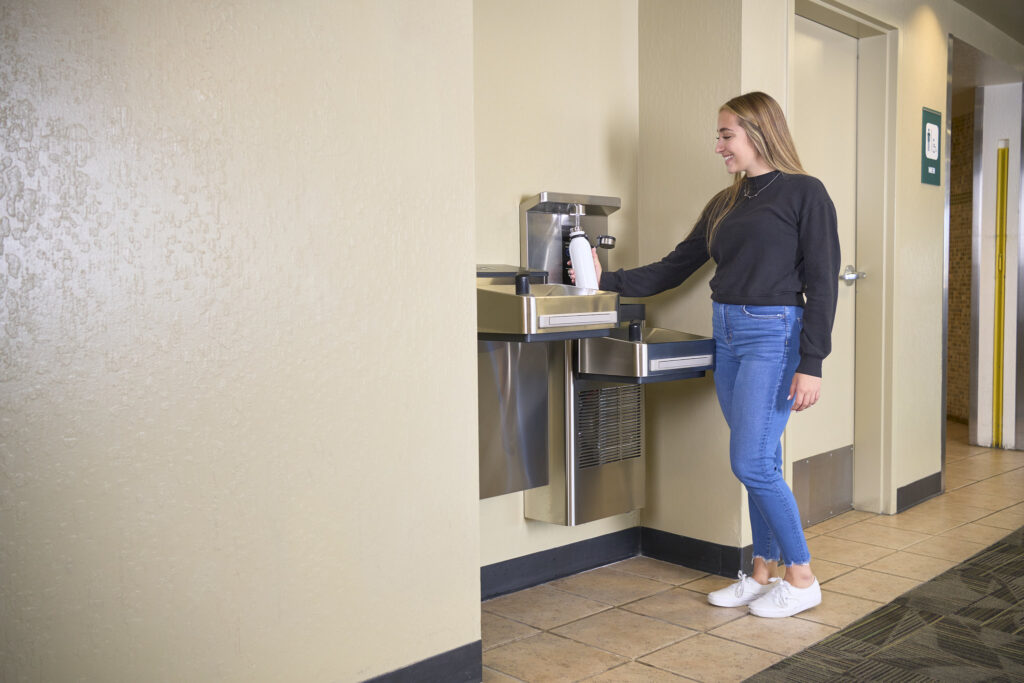Facilities managers must determine what drinking fountain options are available and which will best meet their needs when purchasing drinking fountains, bottle filler stations, or combination fixtures.

To discuss these choices, Justin Dunn, Senior Field Marketing Specialist, and Hayden Del Dotto, Specification Manager, of Haws Corporation presented a webinar on January 25 entitled “Electric Water Cooler and Hydration Overview,” sponsored by Haws.
Facilities managers should also think about solutions that would improve water quality and accessibility for those with disabilities and help reduce the spread of diseases like COVID, as well as order components that are vandal-resistant if they will be installed in high-traffic and heavy-use areas.
“The hydration industry will never be the same post-pandemic. New trends may emerge, but for now, the two remain: bottle fillers everywhere and concerns over the hygienic operation,” Del Dotto said.
Regarding hygienic operations, consider touch-free options, but if there is a need for a button, consider copper touch points. “Copper is a contact-killing material; things like bacteria, yeast, and viruses, on those surfaces that you may touch and pass on,” Dunn said, adding that the life of viruses on copper is half as much as on stainless steel.
Additionally, before installing or retrofitting fixtures, be sure they meet Americans with Disabilities Act (ADA) regulations, and remember that bottle fillers and outdoor drinking fountains cannot be substitutes for indoor drinking fountains, per ADA requirements. For more information, check out Facilities Management Advisor’s article “Ensuring Your Facility’s Drinking Fountain Is ADA Compliant.”
Units
Facilities professionals should consider purchasing one of the following types of units:
- Single or high-low drinking fountains: Single drinking fountains allow only one user, while high-low fountains (with one higher than the other) allow two users simultaneously. High-low units provide better accessibility for users, but single units are better if there are space constraints.
- Bottle filler stations: These are environmentally friendly because they encourage users to refill their own water bottles. Bottle fillers usually are hands-free, and a bottle stand can be added to aid in one-handed operation for those with disabilities. Additionally, a drip tray or catch basin plate can catch spilled water.
- Combination units: These feature a single or high-low drinking fountain and a bottle filler station.
Options
The following options can be added to any of the above units:
- An electric watercooler (EWC) uses a chiller to cool down the water and can come with an energy-efficiency feature to power down after nonuse. This can be retrofitted on many existing units.
- Filtration takes out bad taste and odor, lead, cysts, and other chemicals. An indicator will state the percentage of filter left before it must be changed.
- Touchless stations utilize a motion-activated sensor that starts the water when users go near the sensor. A secondary button can also be installed so the unit will still be functional if the sensor stops working.
- Antimicrobial copper push buttons can be used as a primary or secondary way to turn on the drinking fountain. These are ideal for schools and facilities seeking a quick and inexpensive hygienic solution and can be retrofitted on existing units.
- Consider installing outdoor stations on school campuses, in office courtyards, in parks, and at recreational facilities. Additional options include freeze protection and dog bowls.
Learn More
Whether you’re looking to install drinking fountains, bottle filler stations, or combination units, determine which of the three would best meet users’ needs based on the stations’ intended location.
To learn more about different types of drinking fountains, including EWCs, hygienic improvements, sensor operation, and bottle fillers, you can watch the Haws webinar here.
